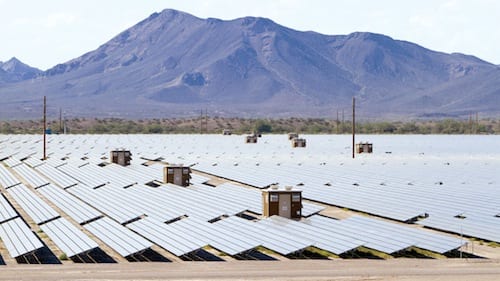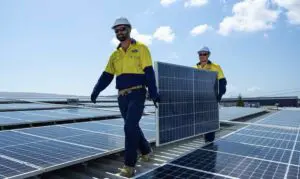The world’s largest solar-panel power plant, the 290MW Agua Caliente project in the US state of Arizona, was fully commissioned last week and will begin sending electricity to California under a 25-year contract.
The project – owned by NRG Energy and MidAmerican Solar, and built on 2,400 acres by First Solar using the Arizona-based company’s thin film cadmium-telluride panels – was backed by a $976 million loan guarantee from the US Department of Energy.
Completion of the plant, which had been operating at 250MW since September 2012, was announced by the US Department of Energy on Tuesday last week, just days after the 250MW Genesis concentrating solar project went on-line in California, and less than three months after Ivanpah, also in California, began feeding into the grid.
 A further two huge DoE-backed PV plants are under construction in California, with the head of the Obama loan program, Peter Davidson, saying in a statement they would be completed by the end of 2015.
A further two huge DoE-backed PV plants are under construction in California, with the head of the Obama loan program, Peter Davidson, saying in a statement they would be completed by the end of 2015.
Davidson has also argued that a side effect of the DoE big solar funding program has been to open the door to private sources of funding.
“Ten additional PV projects larger than 100 megawatts have been announced – all without any DOE financing,” Davidson said. “In 2013, 2,847 megawatts of utility-scale solar was installed in the US, a 58 per cent increase over 2012. Since 2010, total solar capacity in the US has increased by an amazing 418 per cent.”
As Forbes has noted, America’s solar construction boom reflects also state policies to replace fossil fuel power generation with cleaner energy sources. California, for example, requires its utilities to get 33 per cent of their electricity supplies from renewable sources by 2020.
The electricity generated by Agua Caliente – enough to power about 230,000 homes at its maximum production – has been bought by San Francisco-based Pacific Gas and Electric Co under a 25 year contract.
Greentech Media reports that the DoE recently issued a draft solicitation for a new batch of renewable energy loan guarantees, which would be the first since those tied to the 2009 stimulus – and still strongly associated with the high-profile bankruptcy of Solyndra, recipient of a $527 million DoE loan guarantee – closed in September 2011.
The new round of loan guarantees, which could total as much as $4 billion, are said to be targeting the market for technologies in energy storage, waste-to-energy and drop-in biofuels, among others.








